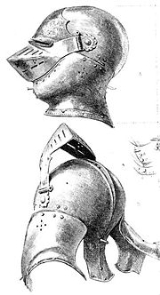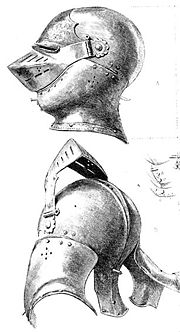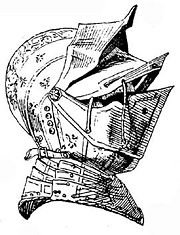
Close helm
Encyclopedia
In Medieval armor, the close helm was a military helmet worn by knights and other combatants in the late medieval and early renaissance era. It carried a visor that pivoted up and fully enclosed the head and neck area, unlike earlier helms such as the sallet
and barbute
, which sometimes may have left the wearer more exposed, or needed a bevor
to be added to protect the chin and neck.

 According to Oakeshot (Ewart Oakeshott "European Weapons and Armour. From Renaissance to the Industrial Revolution" ISBN 0-85115-789-0, page 121 in edition of 2000 by The Boydell Press, Woolbridge), the close helm is a helm which is very similar to an armet
According to Oakeshot (Ewart Oakeshott "European Weapons and Armour. From Renaissance to the Industrial Revolution" ISBN 0-85115-789-0, page 121 in edition of 2000 by The Boydell Press, Woolbridge), the close helm is a helm which is very similar to an armet
, but has a different method of opening. While an armet has two cheekpieces, a close helm instead has a kind of bevor
, which is attached in the same way to pivots as its visor.
However, other authors do not make such difference between close helms and armets: e.g., Wendelin Boeheim in his "Handbuch der Waffenkunde. Das Waffenwesen in seiner historischen Entwicklung vom Beginn des Mittelalters bis zum Ende des 18 Jahrhunders" (Leipzig 1890) does not separate close helms and armets. However, he does separate "Burgundian" Armet as kind of an armet (or a close helm) which has a specific vertigous joint for being attached to a special gorget
made from movable rings.
The close helmet most probably evolved from a number of different helmets, from the armet
, the Italian bellows-visored sallets and possibly hinged great bascinet
s. As a type of helm, they largely appeared in the later 15th century, though there are earlier examples.
The close helm was used in battle, but was also popular in tournaments, where sometimes the visor would be less solid, and instead have bars which would still offer protection but allow more visibility. Close helms for jousting were heavier, weighing up to 12 pounds, while the helms for normal combat were lighter, often around 8 pounds.
As said above, the close helm is very similar to the armet
. The main difference is that the bevor/visor of an armet is split in the middle, with the two halves hinged at the cheek, opening outwards to expose the face of the wearer. The bevor of a 'true' close helm opens by swinging upwards; it is in one piece and shares the pivot point with the visor. The close helm often had a catch to hold the visor down.
Both forms of helm may have had a round plate at the back of the helm, a protective rondel
. The purpose of this is not truly known, but it is suspected that it protected strapping.
Sallet
The sallet was a war helmet that replaced the bascinet in northern Europe and Hungary during the mid-15th century. Some sallets were close fitting except at the back of the head where they extended and formed a pointed tail. Some Italian ones followed the shape of the neck, and had an additional...
and barbute
Barbute
A barbute is a visorless war helmet of 14th to 15th century Italian design, often with distinctive "T" shaped or "Y" shaped opening for the eyes and mouth...
, which sometimes may have left the wearer more exposed, or needed a bevor
Bevor
A bevor is a piece of plate armour designed to protect the neck, much like a gorget. A bevor can be made of a single solid piece or multiple articulated lamés around the neck and chin. The bevor was typically worn in conjunction with a sallet, and later with a burgonet, in a form known as a...
to be added to protect the chin and neck.


Armet
Armet is the name of a type of helmet developed in the 15th century, most likely in Italy, France, Spain and Hungary. It was distinguished by being the first helmet of its era to completely enclose the head while being compact and light enough to move with the wearer...
, but has a different method of opening. While an armet has two cheekpieces, a close helm instead has a kind of bevor
Bevor
A bevor is a piece of plate armour designed to protect the neck, much like a gorget. A bevor can be made of a single solid piece or multiple articulated lamés around the neck and chin. The bevor was typically worn in conjunction with a sallet, and later with a burgonet, in a form known as a...
, which is attached in the same way to pivots as its visor.
However, other authors do not make such difference between close helms and armets: e.g., Wendelin Boeheim in his "Handbuch der Waffenkunde. Das Waffenwesen in seiner historischen Entwicklung vom Beginn des Mittelalters bis zum Ende des 18 Jahrhunders" (Leipzig 1890) does not separate close helms and armets. However, he does separate "Burgundian" Armet as kind of an armet (or a close helm) which has a specific vertigous joint for being attached to a special gorget
Gorget
A gorget originally was a steel or leather collar designed to protect the throat. It was a feature of older types of armour and intended to protect against swords and other non-projectile weapons...
made from movable rings.
The close helmet most probably evolved from a number of different helmets, from the armet
Armet
Armet is the name of a type of helmet developed in the 15th century, most likely in Italy, France, Spain and Hungary. It was distinguished by being the first helmet of its era to completely enclose the head while being compact and light enough to move with the wearer...
, the Italian bellows-visored sallets and possibly hinged great bascinet
Bascinet
The bascinet was a Medieval European open-faced military helmet, typically fitted with an aventail and hinged visor. The term is also written as bassinet or basinet.-Early versions:...
s. As a type of helm, they largely appeared in the later 15th century, though there are earlier examples.
The close helm was used in battle, but was also popular in tournaments, where sometimes the visor would be less solid, and instead have bars which would still offer protection but allow more visibility. Close helms for jousting were heavier, weighing up to 12 pounds, while the helms for normal combat were lighter, often around 8 pounds.
As said above, the close helm is very similar to the armet
Armet
Armet is the name of a type of helmet developed in the 15th century, most likely in Italy, France, Spain and Hungary. It was distinguished by being the first helmet of its era to completely enclose the head while being compact and light enough to move with the wearer...
. The main difference is that the bevor/visor of an armet is split in the middle, with the two halves hinged at the cheek, opening outwards to expose the face of the wearer. The bevor of a 'true' close helm opens by swinging upwards; it is in one piece and shares the pivot point with the visor. The close helm often had a catch to hold the visor down.
Both forms of helm may have had a round plate at the back of the helm, a protective rondel
Rondel (armour)
A rondel is a circular piece of metal used for protection, as part of a harness of plate armour, or attached to a helmet, breastplate, couter or on a gauntlet....
. The purpose of this is not truly known, but it is suspected that it protected strapping.
External
- http://www.eskimo.com/~cwn/close.html Patterns for the Close helm

